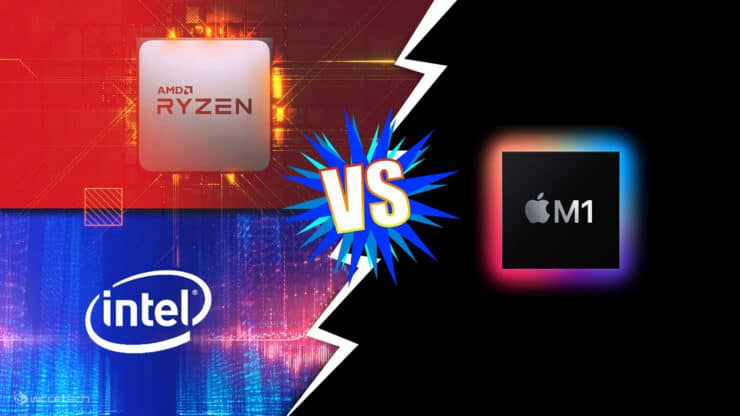
Apple recently made some marketing claims using a 5nm processor against a 4-year old architecture and we were waiting for benchmarks to appear that we can use to do some solid comparisons. Earlier today, the single-core and multi-core scores in the latest Cinebench R23 have leaked out and boy is it a different story than the one Apple used in its announcement. The Apple M1 is a very impressive chip – but the fastest in mobility CPUs it is not – not by a long shot.
Intel and AMD mobility x86 CPUs thrash Apple M1 in Cinebench R23 benchmarks even with a node handicap
It is also interesting that not a lot of people keep in mind that Apple’s M1 is based on the 5nm process – which is a 2 node advantage over Intel 14nm and a 1 node advantage over AMD 7nm. This advantage has nothing to do with Apple’s architectural/engineering prowess and simply a function of the process provided by TSMC. However, even with this handicap, Intel 10nm and AMD 7nm mobility chips thrash out Apple’s M1 in recent Cinebench R23 benchmarks.
Unlike Geekbench, which runs multiple algorithms and then takes a geomean (which can skew results if algorithm-specific optimizations are present on an architecture), Cinebench measures the brute force power of a processor and is the go-to benchmark for most enthusiasts when it comes to processors. It is a rendering benchmark that is able to take complete advantage of all the compute performance of a processor (and all threads) without any inefficiencies. Let’s start with the Cinebench R23 multicore results first:
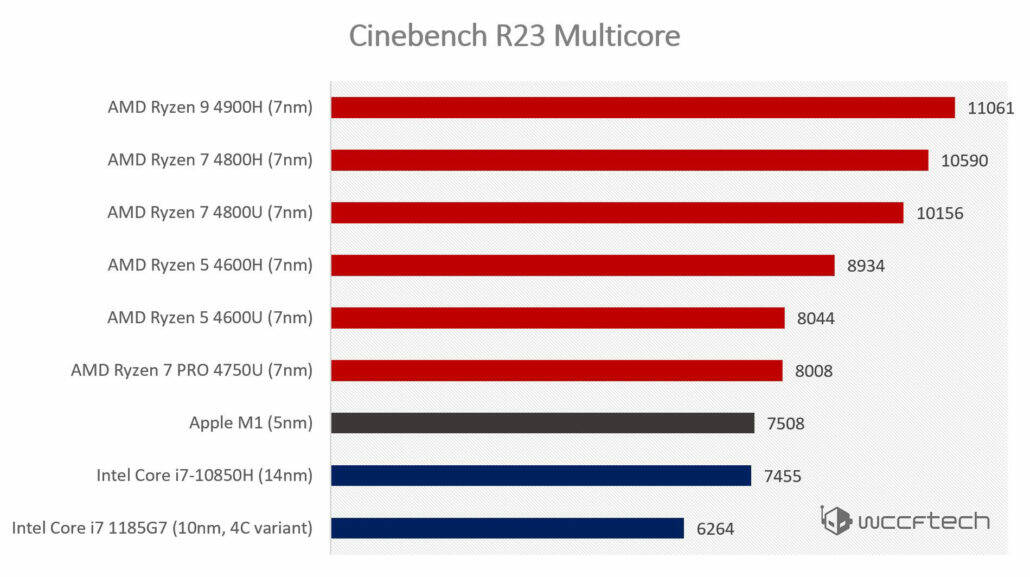
Here, the AMD 7nm chips with a 1 node disadvantage absolutely decimate the Apple 5nm chip. Even Intel’s 14nm processor gets more or less the same score and the 10nm variant (with half the cores!) clocks in at just under 1000 points compared to the Apple M1. The Intel TGL 10nm 8 core variant is expected to land in a few months and it is expected to quickly climb to the top of this chart as well judging from the four-core results shown here. Let’s look at the single-core results now:
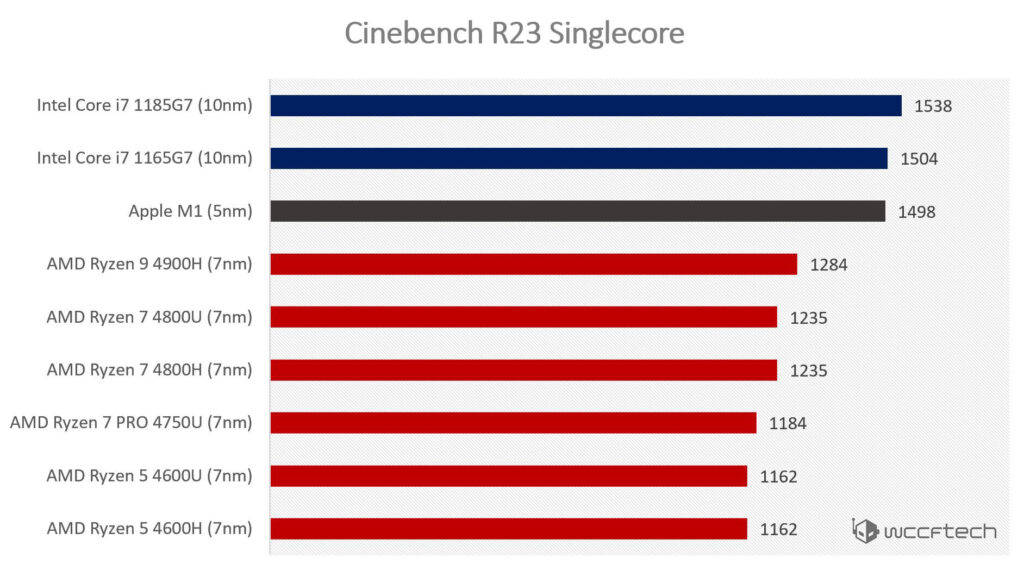
The Apple M1 chip scores 1498 points in Cinebench R23 single-core benchmark. AMD’s x86 chips, which are 1 node behind and do not target very aggressive clocks on single cores (preferring a higher multicore), score up to 1284. On the other hand, the Apple M1 is easily thrashed by an Intel 4-core variant on 10nm: the Intel Core i7 1185G7 which is roughly 1 node behind TSMC’s 5nm process. But of course, the single-core benchmarks are purely cosmetic as most applications use multithreading.
As we can clearly see with these benchmarks, the Apple M1 is not the fastest mobility chip around – by a very long shot. But I do want to point out that shifting to the M1 makes perfect sense for Apple. Because of its exclusivity contract with TSMC, it has access to nodes earlier than anyone else and it can use this node advantage and combine it with its ARM architecture to significantly increase its profit margins without giving away too much performance. In fact, for native code and for the mobile form factor, the performance differences are basically negligible and will not make a difference.
High performance, on the other hand, is another story. I deliberately did not add any desktop processors to these benchmarks but needless to say – even Intel’s 14nm desktop chips destroy the M1. The problem is that ARM architecture doesn’t clock very high and has high leakage at high power levels (this is also conversely true, x86 is not very good at low power scenarios). This means that the x86 market’s bread and butter segments are safe from Apple’s ARM influence – unless companies like NUVIA have something to say about that too.

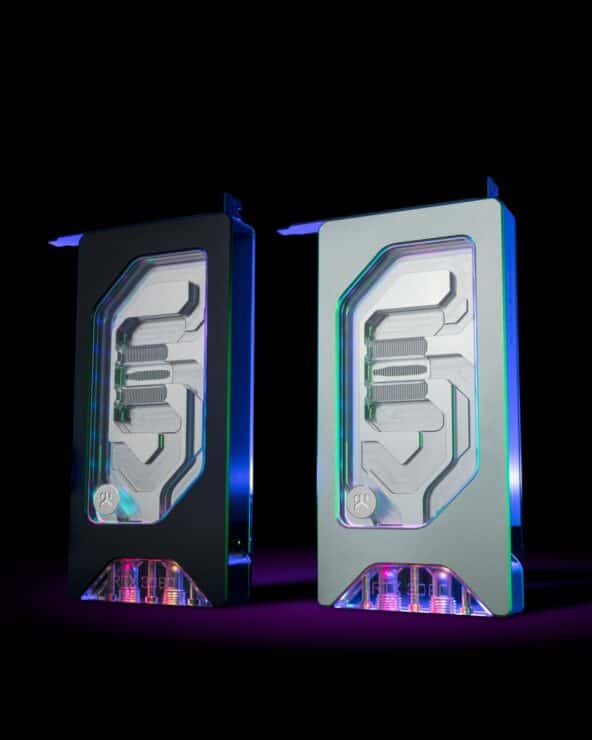


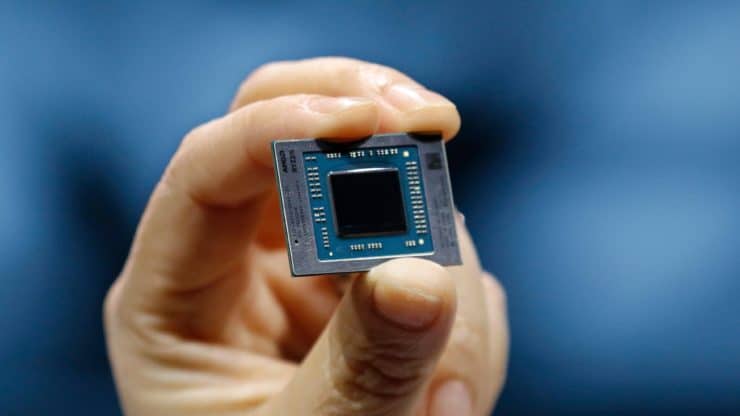
More Stories
EKWB Unveils The Quantum Vector FE RTX 3080 D-RGB – Special Edition Blocks For GeForce RTX 3080 FE Graphics Card
AMD Ryzen 7 5800H 8 Core & 16 Thread Cezanne ‘Zen 3’ High-Performance CPU Shows Up, Early ES Chip With 3.2 GHz Clocks
AMD Ryzen 9 5950X 16 Core Flagship CPU Benchmarked Again, Crushes Intel’s Top Core i9-10980XE 18 Core HEDT Chip